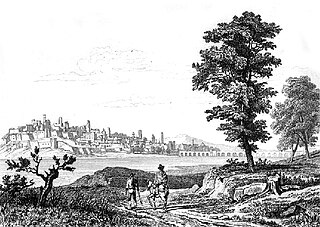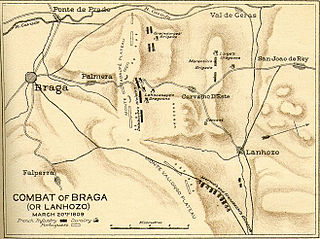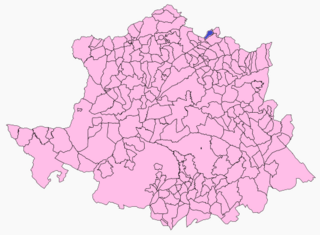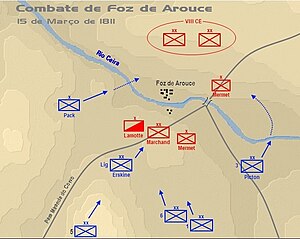
The Peninsular War (1807–1814) was the military conflict fought in the Iberian Peninsula by Portugal, Spain and the United Kingdom against the invading and occupying forces of the First French Empire during the Napoleonic Wars. In Spain, it is considered to overlap with the Spanish War of Independence.

General Julien Augustin Joseph Mermet was a French army general. He fought in the Napoleonic Wars as a division commander in Italy and in the Peninsular War.

The Combat of the Côa was a military engagement that occurred during the Peninsular War period of the Napoleonic Wars. It took place in the valley of the Côa River and it was the first significant battle for the new army of 65,000 men controlled by Marshal André Masséna, as the French prepared for their third invasion of Portugal.

The Battle of Valls was fought on 25 February 1809, during the Peninsular War, between a French force under Laurent Gouvion Saint-Cyr and a Spanish force under Theodor von Reding. Fought near the town of Valls in Catalonia, Spain, the battle ended in a French victory. General Reding was fatally wounded during a cavalry charge against French cavalry.

The Battle of Sabugal was an engagement of the Peninsular War which took place on 3 April 1811 between Anglo-Portuguese forces under Arthur Wellesley and French troops under the command of Marshal André Masséna. It was the last of many skirmishes between Masséna's retreating French forces and those of the Anglo-Portuguese under Wellington, who were pursuing him after the failed 1810 French invasion of Portugal.

Louis Henri Loison briefly joined the French Army in 1787 and after the French Revolution became a junior officer. Blessed with military talent and courage, he rapidly rose to general officer rank during the French Revolutionary Wars. He got into difficulties because of his fondness for plundering. In late 1795 he helped Napoleon Bonaparte crush a revolt against the government. After a hiatus, he returned in 1799 to fight in Switzerland where he earned another promotion. In 1800 he commanded a division under Napoleon in the Marengo campaign.

Major-General Sir William Erskine, 2nd Baronet was an officer in the British Army, served as a member of Parliament, and achieved important commands in the Napoleonic Wars under the Duke of Wellington, but ended his service in insanity and suicide.

Jean Gabriel Marchand, 1st Count Marchand went from being an attorney to a company commander in the army of the First French Republic in 1791. He fought almost exclusively in Italy throughout the French Revolutionary Wars and served on the staffs of a number of generals. He participated in Napoleon Bonaparte's celebrated 1796-1797 Italian campaign. In 1799, he was with army commander Barthélemy Catherine Joubert when that general was killed at Novi. Promoted to general officer soon after, he transferred to the Rhine theater in 1800.

In the Battle of Alba de Tormes on 28 November 1809, an Imperial French corps commanded by François Étienne de Kellermann attacked a Spanish army led by Diego de Cañas y Portocarrero, Duke del Parque. Finding the Spanish army in the midst of crossing the Tormes River, Kellermann did not wait for his infantry under Jean Gabriel Marchand to arrive, but led the French cavalry in a series of charges that routed the Spanish units on the near bank with heavy losses. Del Parque's army was forced to take refuge in the mountains that winter. Alba de Tormes is 21 kilometres (13 mi) southeast of Salamanca, Spain. The action occurred during the Peninsular War, part of the Napoleonic Wars.

The Battle of the Gebora took place during the Peninsular War between Spanish and French armies on 19 February 1811, northwest of Badajoz, Spain. An outnumbered French force routed and nearly destroyed the Spanish Army of Extremadura.

In the Battle of Maguilla a British cavalry brigade led by Major General John Slade attacked a similar-sized French cavalry brigade commanded by General of Brigade Charles Lallemand. The British dragoons scored an initial success, routing the French dragoons and capturing a number of them. The British troopers recklessly galloped after their foes, losing all order. At length, the French reserve squadron charged into the British, followed by the French main body which rallied. With the tables turned, the French dragoons chased the British until the horses of both sides were too exhausted for the battle to continue. The action took place during the Peninsular War, near Maguilla, Spain, a distance of 17 kilometres (11 mi) northeast of Llerena.

In the Battle of the Bidasoa on 7 October 1813 the Allied army of Arthur Wellesley, Marquess of Wellington wrested a foothold on French soil from Nicolas Soult's French army. The Allied troops overran the French lines behind the Bidassoa River on the coast and along the Pyrenees crest between the Bidasoa and La Rhune (Larrun). The nearest towns to the fighting are Irun on the lower Bidassoa and Bera on the middle Bidasoa. The battle occurred during the Peninsular War, part of the wider Napoleonic Wars.

The Battle of Redinha was a rearguard action which took place on March 12, 1811, during Masséna's retreat from Portugal, by a French division under Marshal Ney against a considerably larger Anglo-Portuguese force under Wellington. Challenging the Allies with only one or two divisions, Ney's 7,000 troops were pitched against 25,000 men. In a typical rearguard action, Ney delayed the Allied advance for a day and bought valuable time for the withdrawal of the main body of the French army.

The Battle of Pombal was a sharp but ultimately indecisive skirmish fought at the eponymous town during Marshal Masséna's retreat from the Lines of Torres Vedras, the first in a series of lauded rearguard actions fought by Michel Ney. The French were pursued by Wellington and his British-Portuguese army but the Allied advance was energetically contested by Ney's efforts, preventing Wellington from crushing Masséna's army when it was critically vulnerable.

The Battle of Casal Novo was a rear-guard action fought on March 14, 1811, during Massena's retreat from Portugal. During this retreat a French division, under command of Michel Ney, conducted a series of sharp rear-guard actions. At Casal Novo, the recklessness of Sir William Erskine resulted in costly losses in the Light Division.

In the Battle of Zújar of the Peninsular War, part of the Napoleonic Wars, on 9 August 1811 an Imperial French division from Nicolas Soult's army attacked a Spanish division belonging to Manuel Alberto Freire de Andrade y Armijo's Army of Murcia. The French division, led by Nicolas Godinot, defeated Joseph O'Donnell's Spanish division with heavy losses. Zújar is located on Route 323, 13 kilometres (8 mi) northwest of Baza, Granada in Spain.
The Battle of El Pla was a battle on 15 January 1811 between an Imperial French column made up of two Italian brigades on one side and a Spanish division under the command of Pedro Sarsfield on the other. The Spanish troops held steady and repulsed the attack of the first brigade, then counterattacked and defeated both brigades. The combat occurred during the Peninsular War, part of the Napoleonic Wars. The action was fought near El Pla de Santa Maria, north of Valls, Catalonia, Spain.

In the Battle of Cervera a Spanish force led by Luis Roberto de Lacy attacked a series of Imperial French garrisons belonging to the VII Corps of Marshal Jacques MacDonald. The actions were highly successful and netted nearly 1,000 enemy prisoners. The clashes occurred during the Peninsular War, part of the Napoleonic Wars. The largest garrison was located at Cervera which is located about 55 kilometres (34 mi) east of Lleida, in Catalonia, Spain.

The Battle of Braga or Battle of Póvoa de Lanhoso or Battle of Carvalho d'Este saw an Imperial French corps led by Marshal Nicolas Soult attack a Portuguese army commanded by Baron Eben. When Soult's professional soldiers attacked, the Portuguese at first fought back but soon ran away. The French slaughtered large numbers of their opponents, who were mostly badly disciplined and poorly armed militia. The action was part of the second invasion of Portugal, during the Peninsular War.

The Battle of Puerto de Baños saw a Portuguese-Spanish column led by Robert Wilson attempt to defend a mountain pass against Marshal Michel Ney's VI Corps. After a nine-hour combat, Wilson's force broke up and scattered into the mountains. Baños de Montemayor is located about 45 kilometres (28 mi) northeast of Plasencia, Spain. The clash occurred during the Peninsular War, part of a larger struggle known as the Napoleonic Wars.





















